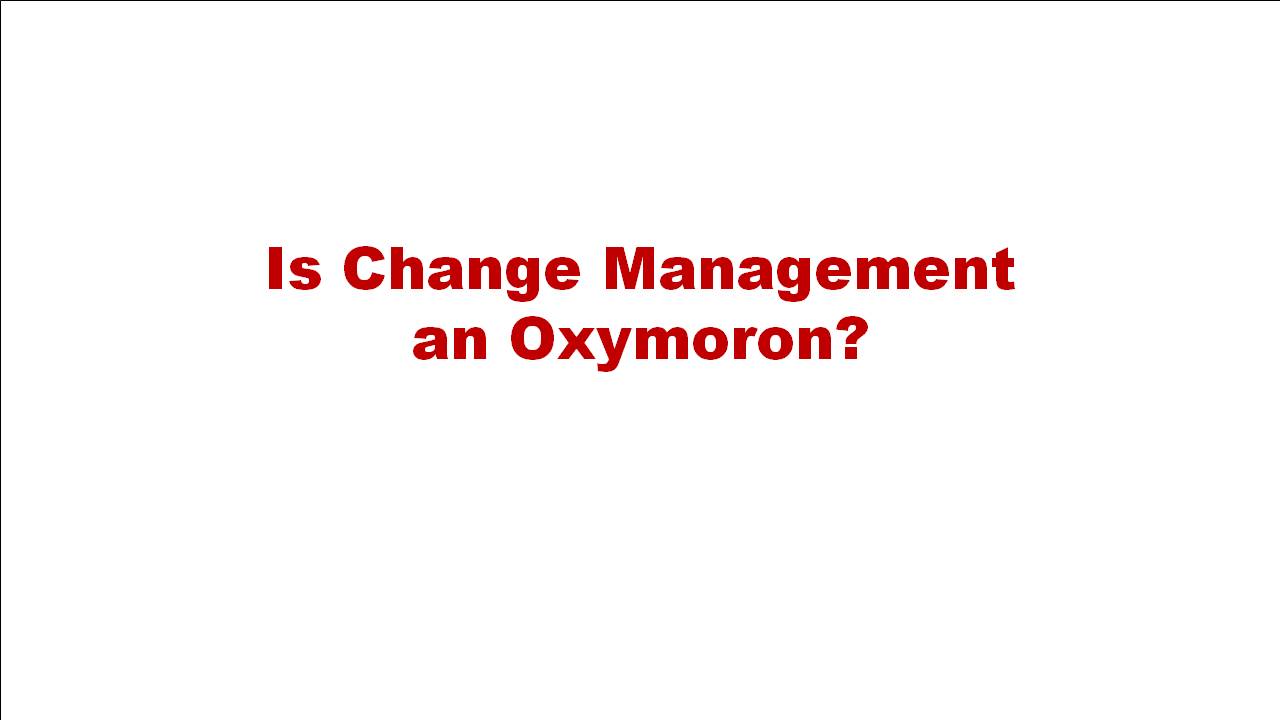by Peter A. Arthur-Smith
“When you think about it, change management is an oxymoron, since management is more about fine-tuning today rather than transforming tomorrow.”

Managers are largely fixated on efficiency, which includes fine-tuning, cost-squeezing and pursuing hyper profitability. On the other hand leaders are more likely focused on effectiveness that includes innovation, breakthroughs and optimal profit solutions. By pursuing optimal profits, it means an appropriate balance between producing elegant outcomes without undue penny-pinching.
Within their mindset, managers are too often inclined to live with the status quo rather than pursue renewal initiatives. They are too often reluctant to upset their current systems or money-spinning apple carts. They are more likely to live with incremental gains rather than seek any true innovation or breakthroughs. Hence the term “change management” sends the wrong signal. In the case of managers it signals limited change with minimal risk.
Leaders by contrast are much more interested in moving beyond bottlenecks or growth constraints, hence are more likely to take reasonable risks. They see risk more as an opportunity rather than a negative barrier. However, they can sometimes become frustrated by snags or insufficient progress, especially when they don’t have the most effective tools available to figure out an optimal way forward. Enlightened leadership (EL) is able to provide such tools. Three EL tools that can aid change or transformation happen to be: 1) Option solving, 2) Success strategies, and 3) Value propositions – all items within an enlightened leader’s toolkit. They are defined as follows:
1) Option Solving – It can aid your objective thinking about market/product/service options. What is the optimal path to pursue for venture success? By posing a question with potential key considerations, it prompts your intuitive mind to search for key decision alternatives. For example: What is your optimal preference for dinner this evening; considering, we 1) have a limited budget, 2) don’t wish to spend much time preparing, 3) prefer wholesome food, and 4) are not in the mood for going out? (Note: We limit them to four considerations to minimize decision complexity.)
Once your question is framed, option solving expects you to flesh-out at least five-options to stretch your thinking; for example 1) Steak dinner, 2) Fish and fries, 3) Shepherd’s Pie, 4)Curry dish, or 5) Garden salad. (Note: This example would be completely different with organizational or business issues to help unearth vital change/transformation options.) When those five plus alternatives are considered, allow at least an hour or two (or even sleep on them) for “emotional distancing;” that is, give your phenomenal intuitive mind the opportunity to decide an optimal way forward. It’s then unwise to second-guess it.
2) Success Strategies – These can come in the form of:
► Simple Success Strategies that specify three interactive components that directly influence performance, namely: 1) compelling Vision-Strategies-Resources, 2) People-power capability, and 3) your Effective-enlightened Leadership. Due thought given to the sub-itemization of these three components will go a long way toward clarifying necessary changes/transformation. (Note: This mode is usually applied to relative start-ups and key teams.)
► Strategic Positioning that frames four key interactive components for fast growth and large ventures, namely: 1) Compelling Vision and Purpose, 2) Vital Knowledge areas required, 3) Essential growth Resources, and 4) Specific Venture and People Outcomes. These four components then form a strategic framework within which your venture performs, grows and flourishes. The resulting outcomes will deliver enormous value within your marketplace and to your customers.
3) Value Propositions – These are focused on what your markets/customers want – an “outside-in” focus – rather than what you desire, an “inside-out” view. Such propositions flesh-out what your products/services reduce and increase in value for your customers. They also flush-out what your products/services eliminate or create in value for your customers/users/beneficiaries. Once itemized, usually several for each, you can now formulate an inspirational statement based upon the most value-priority items. It can then be shared with your customers, people, and other important constituents.
Effective and enlightened leaders are likely to pursue all three and therefore define the vital components necessary to change/transform their teams or ventures ready for future growth cycles. Significant change/ transformation should be pursued with your key leadership team every two to three years, other than when unforeseen market changes or shocks occur. Even then, it’s important for you and your team to review your venture’s journey every 6-12 months to tweak your intentions wherever necessary. By doing all this, you will be clearly viewed as an enlightened leader rather than an incremental conventional manager. Done well, such exercises will spawn an exciting, growth organization that your people will be proud to be associated with!
